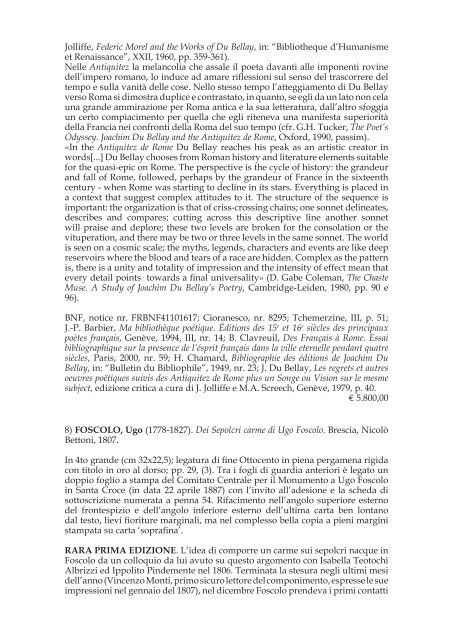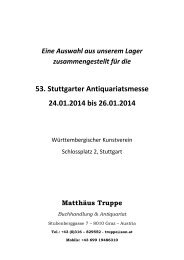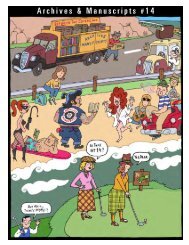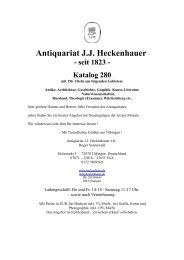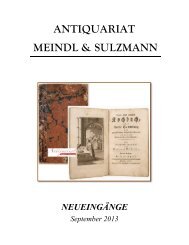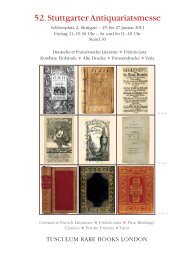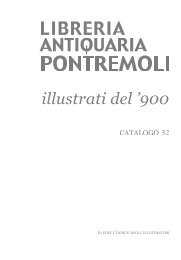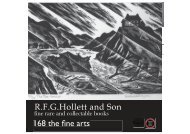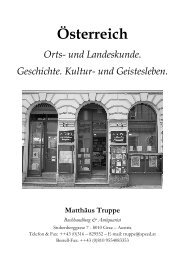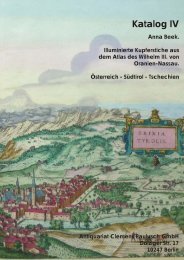Libreria Alberto Govi - Libreria Antiquaria Alberto Govi
Libreria Alberto Govi - Libreria Antiquaria Alberto Govi
Libreria Alberto Govi - Libreria Antiquaria Alberto Govi
Create successful ePaper yourself
Turn your PDF publications into a flip-book with our unique Google optimized e-Paper software.
Jolliffe, Federic Morel and the Works of Du Bellay, in: “Bibliotheque d’Humanisme<br />
et Renaissance”, XXII, 1960, pp. 359-361).<br />
Nelle Antiquitez la melancolia che assale il poeta davanti alle imponenti rovine<br />
dell’impero romano, lo induce ad amare riflessioni sul senso del trascorrere del<br />
tempo e sulla vanità delle cose. Nello stesso tempo l’atteggiamento di Du Bellay<br />
verso Roma si dimostra duplice e contrastato, in quanto, se egli da un lato non cela<br />
una grande ammirazione per Roma antica e la sua letteratura, dall’altro sfoggia<br />
un certo compiacimento per quella che egli riteneva una manifesta superiorità<br />
della Francia nei confronti della Roma del suo tempo (cfr. G.H. Tucker, The Poet’s<br />
Odyssey. Joachim Du Bellay and the Antiquitez de Rome, Oxford, 1990, passim).<br />
«In the Antiquitez de Rome Du Bellay reaches his peak as an artistic creator in<br />
words[...] Du Bellay chooses from Roman history and literature elements suitable<br />
for the quasi-epic on Rome. The perspective is the cycle of history: the grandeur<br />
and fall of Rome, followed, perhaps by the grandeur of France in the sixteenth<br />
century - when Rome was starting to decline in its stars. Everything is placed in<br />
a context that suggest complex attitudes to it. The structure of the sequence is<br />
important: the organization is that of criss-crossing chains; one sonnet delineates,<br />
describes and compares; cutting across this descriptive line another sonnet<br />
will praise and deplore; these two levels are broken for the consolation or the<br />
vituperation, and there may be two or three levels in the same sonnet. The world<br />
is seen on a cosmic scale; the myths, legends, characters and events are like deep<br />
reservoirs where the blood and tears of a race are hidden. Complex as the pattern<br />
is, there is a unity and totality of impression and the intensity of effect mean that<br />
every detail points towards a final universality» (D. Gabe Coleman, The Chaste<br />
Muse. A Study of Joachim Du Bellay’s Poetry, Cambridge-Leiden, 1980, pp. 90 e<br />
96).<br />
BNF, notice nr. FRBNF41101617; Cioranesco, nr. 8295; Tchemerzine, III, p. 51;<br />
J.-P. Barbier, Ma bibliothèque poétique. Éditions des 15 e et 16 e siècles des principaux<br />
poètes français, Genève, 1994, III, nr. 14; B. Clavreuil, Des Français à Rome. Essai<br />
bibliographique sur la presence de l’ésprit français dans la ville eternelle pendant quatre<br />
siècles, Paris, 2000, nr. 59; H. Chamard, Bibliographie des éditions de Joachim Du<br />
Bellay, in: “Bulletin du Bibliophile”, 1949, nr. 23; J. Du Bellay, Les regrets et autres<br />
oeuvres poëtiques suivis des Antiquitez de Rome plus un Songe ou Vision sur le mesme<br />
subject, edizione critica a cura di J. Jolliffe e M.A. Screech, Genève, 1979, p. 40.<br />
€ 5.800,00<br />
8) FOSCOLO, Ugo (1778-1827). Dei Sepolcri carme di Ugo Foscolo. Brescia, Nicolò<br />
Bettoni, 1807.<br />
In 4to grande (cm 32x22,5); legatura di fine Ottocento in piena pergamena rigida<br />
con titolo in oro al dorso; pp. 29, (3). Tra i fogli di guardia anteriori è legato un<br />
doppio foglio a stampa del Comitato Centrale per il Monumento a Ugo Foscolo<br />
in Santa Croce (in data 22 aprile 1887) con l’invito all’adesione e la scheda di<br />
sottoscrizione numerata a penna 54. Rifacimento nell’angolo superiore esterno<br />
del frontespizio e dell’angolo inferiore esterno dell’ultima carta ben lontano<br />
dal testo, lievi fioriture marginali, ma nel complesso bella copia a pieni margini<br />
stampata su carta ‘soprafina’.<br />
RARA PRIMA EDIZIONE. L’idea di comporre un carme sui sepolcri nacque in<br />
Foscolo da un colloquio da lui avuto su questo argomento con Isabella Teotochi<br />
Albrizzi ed Ippolito Pindemente nel 1806. Terminata la stesura negli ultimi mesi<br />
dell’anno (Vincenzo Monti, primo sicuro lettore del componimento, espresse le sue<br />
impressioni nel gennaio del 1807), nel dicembre Foscolo prendeva i primi contatti


